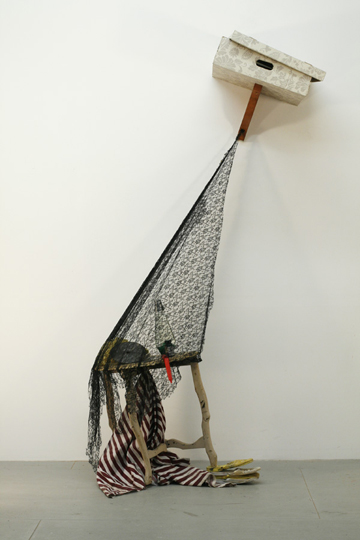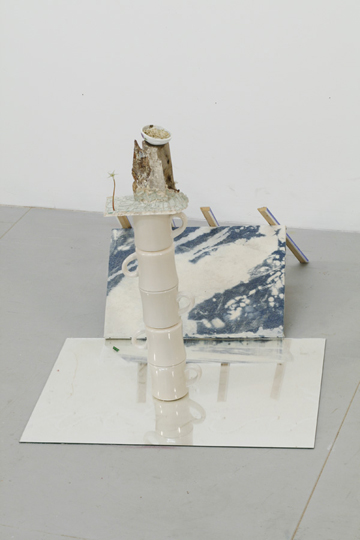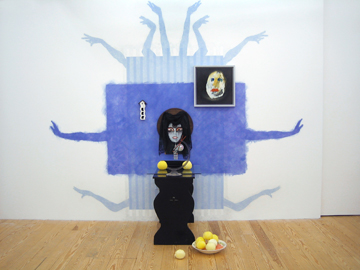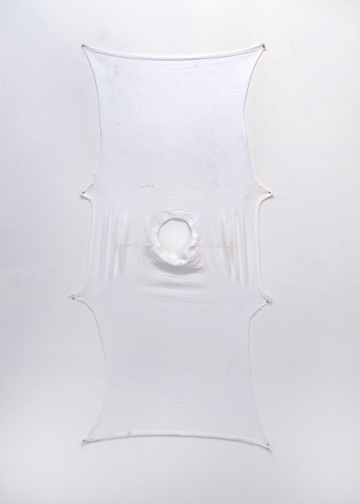The artist Matthew Savitsky has based himself in Philadelphia for the past three years after a lengthy tenure in New York. His practice primarily spans sculpture and painting, working with lived materials in response to lived experiences. A meticulous hoarder, he often incorporates personal belongings into his sculptures, installations and tableaux inspired by his own, continual upbringing and relationships to and within communities: Methodist, Pennsylvania Dutch roots; the pristine, coded culture of galleries and collectors; the geographically dispersed Radical Faeries network of intergenerational gay men; decorative trades that monetize craftsmanship to realize clients’ personal visual fantasies, like muralism and interior design. His works convey a kind of autobiographical exhibitionism, formal therapy processing subjective elements of life, ideas and reflections on culture.
Kevin McGarry: Hi Matthew, what’s the story behind your most recent project, Healing With Purple (Here Lies Helvetica)?
Matthew Savitsky: I wanted to make this reliquary/headstone after visiting Short Mountain, Tennessee. As some kind of rite of passage, my friend/faerie elder Albo led me on a hike to a “faerie cemetery” where people handcrafted graves for dead queens—many whom had passed on during the AIDS crisis. To my understanding Short Mountain served largely as a refuge for those suffering during that time. The plots were done up with high heels, lashes, glitter (lots of glitter), toys, old photographs, stones, bones… I remember feeling an acute connectedness and sense of history in that space. There was a world of love and pride right there, in an apparently invisible spot.
I always want to translate how profound moments like that feel, but I’m so limited once I’m back at work, isolated in a studio. I think my work becomes about re-posturing those moments of love as displaced and superficial, how these inspirations intrinsically feel out of context once they are put into an art context. Sensing this while working on Helvetica, I decided to follow a phony, coffee table guide to positively affecting your living space using color as a way to drain the blood out of something personal.

Matthew Savitsky, Obituary, linen box, fabric, lace, slippers, candles, pills, lava lamp, saw blade, yarn, photograph, table, 2007
McGarry: Several of your sculptures embody a narrative sensibility, Obituary as an example (the precariously balanced box, lace stretched down diagonally, personal effects on the table…) Are you working with a semblance of a story? Working against one?
Savitsky: Back then I needed a little story in my head before I started working, to make me feel secure enough to begin the actual work, which is actually all about improvisation and guesswork. I have been trying to free myself from the aspect of a work that may seem “solvable:” where objects serve to over-explain literal details. In Obituary, I focused on a representation of a mother grieving a son killed in the Iraq War: all of the clutter is a shrine to him. What I realize now is that, in a broader sense, my interest was in exaggerated representations of women’s emotional states. Clinging to a larger, “relevant narrative” is a strategy I assumed was necessary in order to talk about what actually resonated with me: in this case, a lack of space in society for women to be represented neutrally.
Lately I try to notice and hold on to the immediacy of the actions that shape the composition of works, the actions that leave elements set, placed, stretched, tipped, hung, spread, left. I love Robert Gober for his radical sense of placement. I love that room at The New Museum right now where one wall is covered with vignettes of roads rolling over hills to a horizon with a pair of legs spread wide open—so wide that the toes touch either wall!

Matthew Savitsky, Poem about People, bleached denim, mirror, sawdust, mugs, paper pulp, glass, wood, toenail clippings, frame, 2008
McGarry: Is a similar process behind Poem about People? While I sense a narrative here, too, this piece seems more conscious of the abstract, formal meanings of its components and composition, with less of an emphasis on the theater of rearranging objects that serve more tangible functions before they are offered as art.
Savitsky: Yes! But I don’t work this way so much anymore. At the time I was writing a lot, more like journaling though. I’m continually frustrated about not being a better writer, and this was my best attempt at “writing a poem.” Also, I think art should read like poetry and not be this thing that’s thought out ahead of time and executed. On top of the coffee cup spine sits a tiny dish of toenail clippings I privately saved from middle school through my first year of college. I stopped because there just weren’t as many as I thought there would be by then!
McGarry: While you often employ an animated, somewhat craftsy aesthetic, recent pieces like Sisley and Window Painting (Green Screen) are minimal by comparison. Do you read your entire output as an evolving series, in which case opposed styles might reveal mutual dimensions of each other?
Savitsky: It is certainly all an evolving series. I like each work to represent my exact emotional state the day it’s made instead of becoming a line of consistent products over time. I like the content to remain open for mutation and manipulation in the future. In a literal way, I often reuse elements of past work and resituate them in new works. I have a hard time letting go of the past. Of course a lot of what’s there are strings of symbols that appear in tides—most noticeably they stem from my sheltered, religious background and from my chosen participation in gay communities.
In the past my conflicting identities have found common ground in the practices of craft and domestication. Craft is about making something from nothing. In the dramatics of my mind, I’ve done the same for myself as a gay person: risen against many odds with primitive tools to face and explore my gay self. TA-DA! I think this is generally something that many gay men feel. My homes have always been places where I can assert control and make “gay space”. Now that I’m more aware of this I think my newer works are more minimal because I’ve been able to conceptualize the impulse to decorate, arrange, dress up—fag out. I cut out all the crap that means to attach itself to known, prominent, “relevant” ideas (for the sake of identifying with a broader, intellectual conversation), and cut straight to subjects I want to focus on.
McGarry: How do these social and sexual identifications intersect with how you identify as an artist? Do the popular narratives of famous gay artists have bearing on your thinking or work?
Savitsky: I’ve been very focused on these matters over the past year and my head is mixing a million responses that haven’t all convened yet. At this point I have the urge to communicate using ” gay ” colloquialisms and sensibilities to explore things that are culturally “ours.” I read Wayne Koestenbaums’ book The Queen’s Throat last year and it really helped me reclaim the lovely private parts about being gay, like, before the outing ritual—because so much of what transpires in any “gay exchange” is charged in a way that feels public: exposed. Wayne mentions the times when you call some company and a gay receptionist, living in the middle of America answers on the other side. There is communication on two levels, one about an upgrade or whatever, and another that says “Hay, Girl!”
I think about this in relation to an artist like Felix Gonzales Torres, who translates the realm of being “close with strangers” (cruising, the gay gaze, etc.), but who has been canonized in a way that transcends the distinction of “gay artist” due to his work’s use of cool conceptualism to dissolve the trauma, hatred and paranoia historically surrounding gay people. I always wonder if readings of his work focused on his experiences of real and estranged love are mired in our human tendency to subjectively simplify and politicize history. Knowing comes down to being there, and there’s so much we can’t be there for. I want to know what the etiquette of an art conversation was like between gay artists during the AIDS crisis and even before. You always hear that Rauschenberg wouldn’t hang with Warhol because he was “too swish.”- stuff like that. If Felix’s work was chosen to represent that time, who was shut out? In what ways do I idealize gay history (the past) to dramatize my present scenario?
I think of Jasper Johns, too. I imagine what his hand looks like swishing those little patches of confetti color. It’s actually so funny when you think of his hand working compared to DeKooning’s. Once I started to notice these gay nods more, certain works were humanized for me from a personal perspective, and I started have new and important museum experiences. I want to continue in this tradition without being pigeonholed as a gay artist—which becomes a bizarre problem if you choose to be explicit about these issues.
Speaking of, I want to start this new project that tells a story through splayed gowns pinned to the wall (like Sisley and Turtleneck) that describes Wayne’s trajectory of the diva as one who imitates, covers up, sashays, debuts, clings and self-destructs. I want to see if a visual representation of this dramatic arch can be told through the particularities and fabulosities of each gown. I may also try to do this by breaking down each phase of Ms. Holly Woodlawn’s gesticulating in this youtube starting around 3:25. This is a must see! https://www.youtube.com/watch?v=U5wuwngAXGA
McGarry: And maybe this is a pertinent addendum… can you discuss your interest in holes?
Savitsky: I prefer openings! 😉 I love the mystery of an abstract puncture. Dennis Cooper memorably describes an ass in this way. I don’t necessarily see the openings as assholes, but they are always symbolic passages. For a while I was drilling holes in these paintings and drawings of drag queens. I’d make holes in their makeup which usually extends high above the brow as a way to poke fun at the “third eye” and have the makeup appear like the natural markings on an insect.








Pingback: Election présidentielle au Togo: Matthew Cichocki, un citoyen européen, a commencé en grève de la faim | Voiture
Pingback: What’s Cookin at the Art21 Blog: A Weekly Index | Art21 Blog